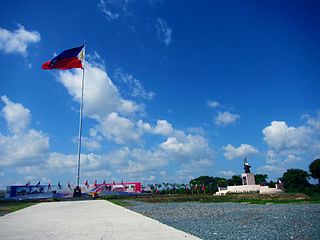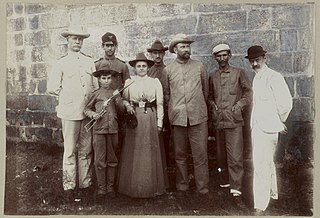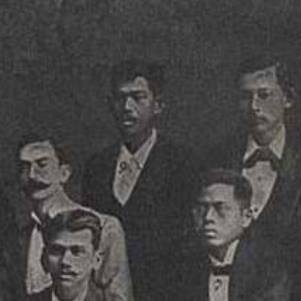
Emilio Aguinaldo y Famy was a Filipino revolutionary, statesman, and military leader who became the first president of the Philippines (1899–1901), and the first president of an Asian constitutional republic. He led the Philippine forces first against Spain in the Philippine Revolution (1896–1898), then in the Spanish–American War (1898), and finally against the United States during the Philippine–American War (1899–1901). Though he was not recognized outside of the revolutionary Philippines, he is regarded in the Philippines as having been the country's first president during the period of the First Philippine Republic.

Laguna, officially the Province of Laguna, is a province in the Philippines located in the Calabarzon region in Luzon. Its capital is Santa Cruz while its largest city is the City of Calamba and the province is situated southeast of Metro Manila, south of the province of Rizal, west of Quezon, north of Batangas and east of Cavite. Laguna hugs the southern shores of Laguna de Bay, the largest lake in the country. As of the 2020 census, the total population of Laguna is 3,382,193. Among all 82 provinces in the Philippines, Laguna accounted for the largest share (5%) of the national Gross Domestic Product (GDP) with a total of Php 990.69 billion in 2022.

The Philippine Revolution was a war of independence waged by the revolutionary organization Katipunan against the Spanish Empire from 1896 to 1898. It was the culmination of the 333-year colonial rule of Spain in the archipelago. The Philippines was one of the last major colonies of the Spanish Empire, which had already suffered a massive decline in the 1820s. Cuba rebelled in 1895, and in 1898, the United States intervened and the Spanish soon capitulated. In June, Philippine revolutionaries declared independence. However, it was not recognized by Spain, which sold the islands to the United States in the Treaty of Paris.

Miguel Malvar y Carpio was a Filipino general who served during the Philippine Revolution and, subsequently, during the Philippine–American War. He assumed command of the Philippine revolutionary forces during the latter, following the capture of resistance leader Emilio Aguinaldo by the Americans in 1901. According to some, he could have been listed as one of the presidents of the Philippines. However, is not recognized as such by the Philippine government.

Juan Cailles y Kauppama was a Filipino general and politician. A member of the revolutionary movement Katipunan, he was a commanding officer of the Philippine Revolutionary Army who served during the Philippine Revolution and Philippine–American War. He later served as a provincial governor of Laguna and a representative from Mountain Province.

This Battle of Santa Cruz was fought in the early stages of the Philippine–American War during General Henry W. Lawton's Laguna de Bay campaign.

Artemio Ricarte y García was a Filipino general during the Philippine Revolution and the Philippine–American War. He is regarded as the Father of the Philippine Army, and the first Chief of Staff of the Armed Forces of the Philippines though the present Philippine Army descended from the American-allied forces that defeated the Philippine Revolutionary Army led by General Ricarte. Ricarte is notable for never having taken an oath of allegiance to the United States government that occupied the Philippines from 1898 to 1946.

The Magdiwang was a faction of the Katipunan, a Philippine revolutionary organization founded by Filipino rebels in Manila in 1892 with the aim to gain independence from Spain. The Magdiwang Council was acknowledged as "the supreme organ responsible for the successful campaigns against the enemy" within Cavite.

Paciano Rizal Mercado y Alonso Realonda was a Filipino general and revolutionary, and the older brother of José Rizal, the national hero of the Philippines.

Fighting erupted between forces of the United States and those of the Philippine Republic on February 4, 1899, in what became known as the 1899 Battle of Manila. On June 2, 1899, the First Philippine Republic officially declared war against the United States. The war officially ended on July 2, 1902, with a victory for the United States. However, some Philippine groups—led by veterans of the Katipunan, a Philippine revolutionary society—continued to battle the American forces for several more years. Among those leaders was General Macario Sakay, a veteran Katipunan member who assumed the presidency of the proclaimed Tagalog Republic, formed in 1902 after the capture of President Emilio Aguinaldo. Other groups, including the Moro, Bicol and Pulahan peoples, continued hostilities in remote areas and islands, until their final defeat at the Battle of Bud Bagsak on June 15, 1913.

The Battle of Binakayan–Dalahican was a simultaneous battle during the Philippine Revolution that was fought on November 9–11, 1896 that led to a decisive Filipino victory. The twin battle took place at the shores of Binakayan, in the town of Cavite Viejo ; Dalahican and Dagatan in Noveleta; and, to minimal extent, in Imus and Bacoor towns in Cavite, Philippines that lasted for two days before the Spanish army retreated demoralized and in disarray. The result of the battle was the first significant Filipino victory in the country's history.

The Battle of Alapan was fought on May 28, 1898, and was the first military victory of the Filipino Revolutionaries led by Emilio Aguinaldo after his return to the Philippines from Hong Kong. After the American naval victory in the Battle of Manila Bay, Aguinaldo returned from exile in Hong Kong, reconstituted the Philippine Revolutionary Army, and fought against the Spanish troops in a garrison in Alapan, Imus, Cavite. The battle lasted for five hours, from 10:00 A.M. to 3:00 P.M.
The Battle of Pateros refers to a series of skirmishes between Spanish troops and revolutionary forces in the towns of Las Piñas, Taguig and Pateros in Manila. These skirmishes occurred shortly after the execution of José Rizal and are considered the renewal of hostilities in Luzon after a period of ceasefire from the Battle of Binakayan to the Rizal execution.

The Battle of Calamba was fought between Filipino Revolutionaries in La Laguna in the Philippines and the colonial forces of the Spanish Empire.
The Battle of Tayabas was a 2-month campaign of the Philippine Revolution that saw intense guerrilla warfare and bloodshed for the province. The battle occurred shortly after Aguinaldo's return from Hong Kong in May of the same year. Tayabas was just one of the many triumphs for the revolutionaries in that year, that led towards Philippine independence.
Regino Díaz Relova was a Filipino revolutionary who fought during the Philippine Revolution in Los Baños, Bay, Calauan and his hometown Pila, Laguna during the Philippine–American War. He was ranked as a lieutenant colonel of the Katipunan.

The Battle of Sambat was the culminating battle of the first revolts of the Katipunan in Laguna. The battle was the final major action for the Katipunan chapter of "Maluningning" ending in the defeat of the rebels and martial law in Laguna province.
This is the timeline of the Philippine Revolution—the uprising that gave birth to Asia's first republic. The roots of the revolution trace back to the Cavite mutiny and subsequent execution of Gomburza in 1872, and ended with the declaration of independence from Spain in 1898.

Salvador Estrella was a Filipino general who fought in the Philippine Revolution and the Philippine–American War. For his courage in battle, he earned the moniker "red blooded."

The Battle of Mount Puray, sometimes known as Battle of Mount Purog, was fought on June 14, 1897, between the Philippine revolutionaries led by Revolutionary President Emilio Aguinaldo and General Licerio Geronimo and Spanish forces sent under orders by Governor-General Fernando Primo de Rivera. Filipino forces won a victory in this battle in which a Spanish army pursuing them was crushed and routed. The Filipinos' victory in the battle ended the long evacuation from Cavite to Morong, and made possible the setting up of their new revolutionary headquarters in the battlefield's vicinity and then later to Biac-na-Bato in Bulacan.















